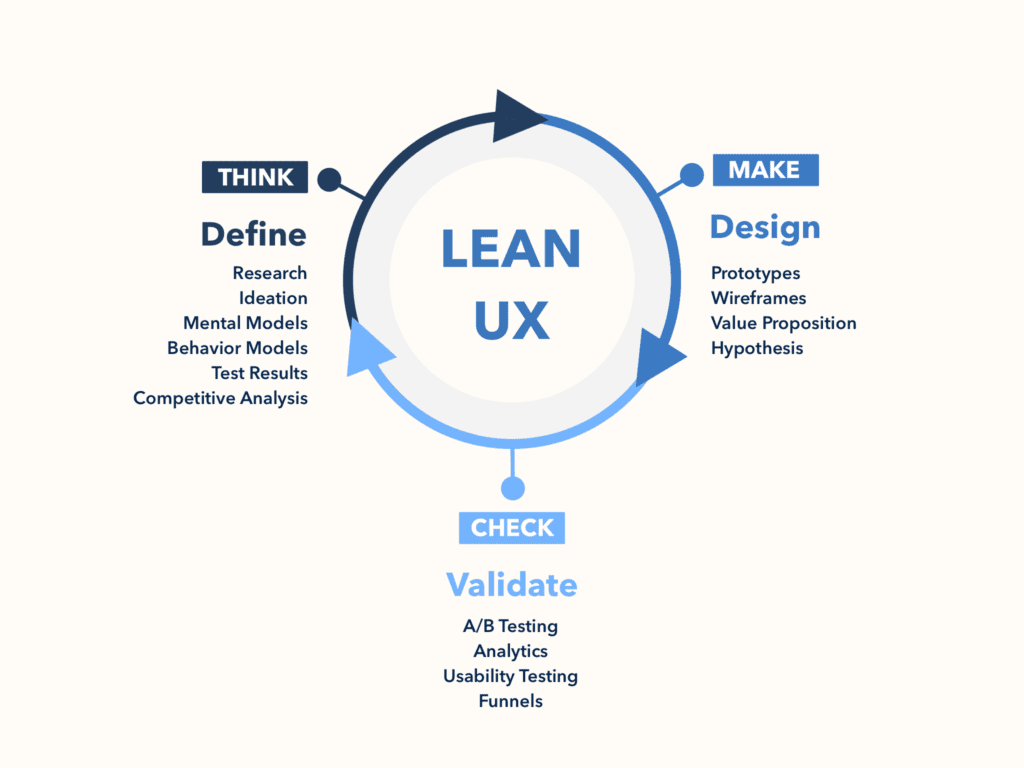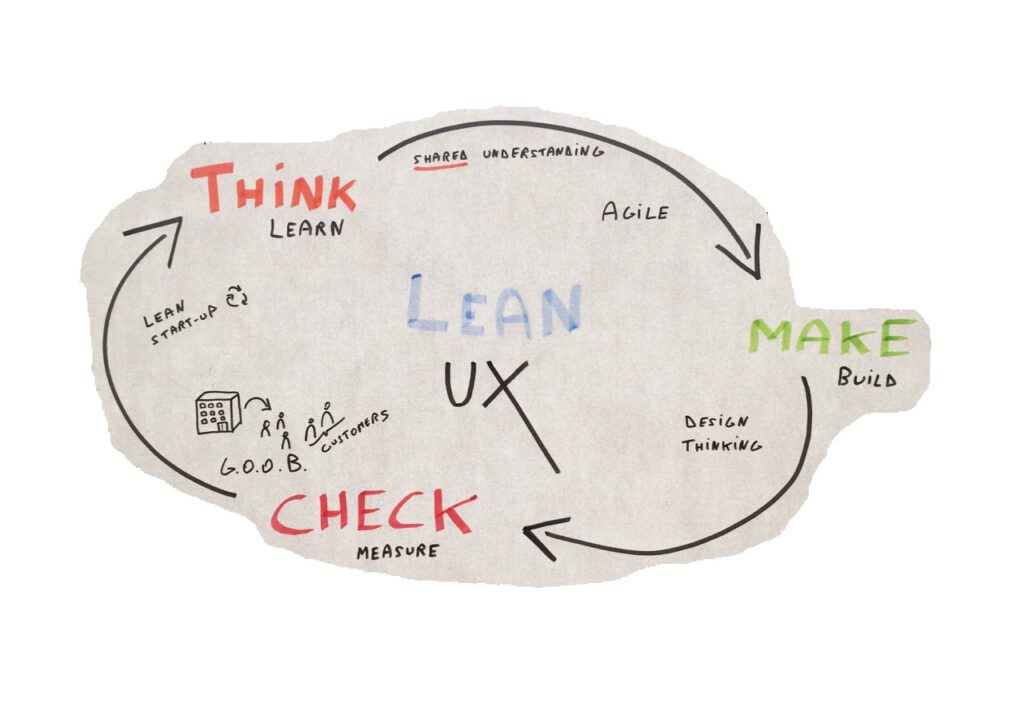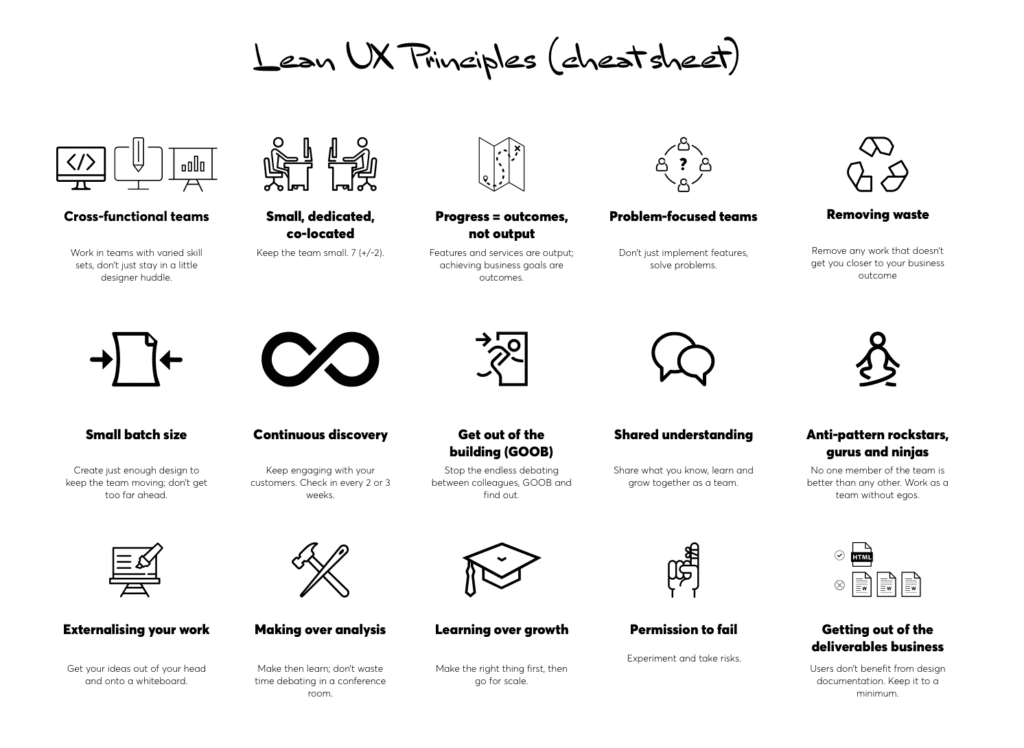In today’s fast-paced digital landscape, organizations continually seek ways to design products that not only meet user needs but also evolve quickly with market demands. Lean UX has emerged as a popular methodology for achieving user-centered design efficiently. This article examines what Lean UX is, why it’s advantageous, how organizations utilize it, instances where it has faltered, and suggestions for improvement.
Understanding Lean UX
Lean UX is rooted in Lean Startup principles, which emphasize rapid iteration and experimenting to create products that resonate with users. Unlike traditional UX approaches, which often involve extensive documentation and lengthy design phases, Lean UX focuses on collaboration among cross-functional teams, rapid prototyping, and continuous feedback. The goal is to create minimum viable products (MVPs) that can evolve based on real user experiences and insights.
The Benefits of Lean UX
- Speed and Agility: One of the most significant advantages of Lean UX is the speed it offers. By prioritizing quick iterations and user feedback over exhaustive design documentation, teams can move swiftly from ideas to prototypes. This allows organizations to test assumptions and get products into the hands of users faster.
- User-Centric Focus: Lean UX places a strong emphasis on understanding the users and their needs. By involving users early and often in the design process, organizations can uncover valuable insights that drive better decision-making. This focus on user feedback leads to outcomes that resonate more effectively with the target audience.
- Collaboration and Transparency: Lean UX encourages a collaborative approach, involving various stakeholders, including designers, developers, product managers, and users. This collective effort fosters transparency and alignment on objectives, leading to better overall product quality and team cohesion.
- Cost Efficiency: Rapid prototyping and early testing can reduce costs associated with development. By identifying flaws early, organizations can pivot before investing heavily in a flawed concept, ultimately saving time and resources.
Implementation in Organizations
Many organizations across industries have embraced Lean UX, integrating it into their design and development processes. Tech companies like Spotify and Airbnb have famously employed Lean UX principles to iterate on their products based on user feedback. These companies often conduct design sprints that push teams to rapidly brainstorm, prototype, and test ideas within a short timeframe.
In startups, where resources are limited, Lean UX is often inherently part of the culture. The emphasis on MVPs allows startups to launch quickly, learn from their users, and iterate without being bogged down by unnecessary bureaucracy.
Moreover, established organizations have begun restructuring their product teams to adapt Lean UX principles. By breaking down silos between departments, these organizations encourage collaboration that leads to innovations driven by user insights.

Where Lean UX Can Go Wrong
Despite its many advantages, Lean UX has not been without challenges. One of the primary pitfalls is the neglect of comprehensive research. In the rush to produce and iterate, some teams might skip thorough user research, leading to design decisions based on limited feedback. This can result in products that miss the mark for certain user segments.
Additionally, the emphasis on speed can sometimes compromise depth. Quick tests can lead to superficial insights, and teams may inadvertently ignore critical user stories or pain points. As a result, products may suffer from a lack of substantial engagement or functionality.
Poor alignment and communication within teams can also hinder the effectiveness of Lean UX. If team members are not on the same page regarding objectives, the iteration process may yield misaligned results that do not serve the end user effectively.
Lean UX is a design methodology that prioritizes rapid prototyping, testing, and iteration to swiftly create and enhance user experiences. While it has gained significant traction among design teams and is lauded for enabling quick and efficient workflows, it has also encountered criticism. Some common concerns regarding Lean UX include:
- Short-Term Focus: Critics argue that Lean UX may lean too heavily on immediate solutions, potentially neglecting the long-term goals and overall strategy of a product or business.
- Risk of Overlooking User Needs: The emphasis on rapid iteration can, at times, cause teams to prioritize short-term achievements over a comprehensive understanding of user needs. This may result in solutions that do not fully address the broader context of user experiences.
- Exclusion of Stakeholders: Lean UX often centers on the specific needs of a targeted user group, which can inadvertently lead to the exclusion of other important stakeholders from the design process.
- Limited Applicability: While Lean UX is effective for developing specific features or products, it may not be well-suited for larger, more complex projects that require a thorough and comprehensive design approach.
In summary, while Lean UX has proven beneficial for many teams, organizations should carefully evaluate whether it aligns with their specific needs and long-term objectives.

Enhancing Lean UX
To address these shortcomings, organizations can take several steps to improve their implementation of Lean UX.
- Integrate Comprehensive Research: While quick iterations are essential, teams should not forgo deeper research. Using techniques like ethnographic studies, journey mapping, or in-depth interviews alongside rapid prototyping can yield valuable insights that guide design more effectively.
- Encourage Continuous Learning: Establish a culture that values learning from both successes and failures. Teams should review outcomes from each iteration and adapt practices based on findings rather than just moving on to the next cycle.
- Facilitate Open Communication: Clear communication remains key to successful collaboration. Employ tools and regular check-ins to ensure that all team members are aligned with objectives, findings, and next steps.
- Enhance User Involvement: Organizations should strive to involve users throughout the design process, beyond just initial testing. Continuous feedback mechanisms, such as surveys or usability tests at different phases, can keep user needs at the forefront.
Key insights
- Lean UX is an outcome-based design process that prioritizes collaboration, testing, and experimentation on MVPs.
- Lean UX focuses on “why” rather than “what”, requiring designers to find reasons and supporting data for their design decisions.
- Lean UX optimizes UX workflows by encouraging cross-functional collaboration and avoiding unnecessary processes.
- The Lean UX methodology consists of making assumptions, testing hypotheses, and building MVPs to quickly validate ideas.

Conclusion
Lean UX presents a valuable approach to design in today’s rapidly changing environment, offering benefits like speed, user-centric focus, and cost efficiency. While there are challenges, with the right strategies to mitigate these pitfalls, organizations can harness Lean UX to create meaningful products that resonate with users and adapt to their evolving needs. Ultimately, when executed effectively, Lean UX can drive innovation and ensure that teams remain agile in their quest to deliver exceptional user experiences.
One weakness that has tripped us up so far is not recognizing the complexity of a legacy system before jumping in with updates. The deeper we dug into the project the more “states” we discovered that required updating. Our estimate for that iteration was way off leaving us in a bit of a lurch.
-Jeff Gothelf (author of Lean UX: Designing Great Products with Agile Teams)
If you’re using lean UX while working on legacy systems I would encourage you to take the extra time to understand the logic before jumping in head first.
Disclaimer: The information contained in this post is for general information purposes only. The views expressed here are my own and do not necessarily reflect the opinions or positions of my employers, clients, or any organizations with which I am affiliated.
The audio summary segments, included for accessibility, are generated with experimental NotebookLM.

